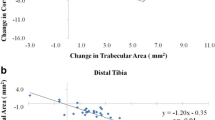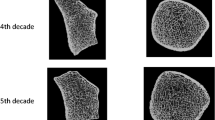Abstract
Summary
Evidence of measurement precision, annual changes and monitoring time interval is essential when designing and interpreting longitudinal studies. Despite the precise measures, small annual changes in bone properties led to monitoring time intervals (MTIs) of 2–6 years in peripheral quantitative computed tomography (pQCT)-derived radial and tibial bone area, density, and estimated strength in postmenopausal women.
Introduction
The purpose of the study was to determine the precision error, annual change, and MTI in bone density, area, and strength parameters in postmenopausal women.
Methods
Postmenopausal women (n = 114) from the Saskatoon cohort of the Canadian Multicentre Osteoporosis Study had annual pQCT scans of the distal and shaft sites of the radius and tibia for 2 years. Median annualized rates of percent change and the MTI were calculated for bone density, area, and strength parameters. Root mean squared coefficients of variation (CV%) were calculated from duplicate scans in a random subgroup of 35 postmenopausal women.
Results
CV% ranged from 1.4 to 6.1 % at the radius and 0.7 to 2.1 % at the tibia. MTIs for the distal radius were 3 years for total bone density (ToD) and 4 years for total bone cross sectional area (ToA), trabecular area, and bone strength index. At the diaphyseal radius, MTI was 3 years for ToA, 5 years for cortical density, and 6 years for polar stress strain index (SSIp). Similarly, MTI for total and trabecular density was 3 years at the distal tibia. At the diaphyseal tibia, MTI for ToA was 3 years and SSIp 4 years.
Conclusion
MTI for longitudinal studies in older postmenopausal women should be at least 2–6 years at the radius and tibia, with specific monitoring of the total and trabecular area, total density, and bone strength at the radius and total and trabecular density, total area, and bone strength at the tibia.
Similar content being viewed by others
References
WHO (1994) Assessment of fracture risk and its application to screening for postmenopausal osteoporosis, (Rome, Italy, June 22-25, 1992). WHO Technical Report Series 0:I-130
Kanis JA (2002) Diagnosis of osteoporosis and assessment of fracture risk. Lancet 359:1929–1936
Siris ES, Miller PD, Barrett-Connor E, Faulkner KG, Wehren LE, Abbott TA, Berger ML, Santora AC, Sherwood LM (2001) Identification and fracture outcomes of undiagnosed low bone mineral density in postmenopausal women—results from the National Osteoporosis Risk Assessment. JAMA 286:2815–2822
Bonnick SL (2007) HSA: beyond BMD with DXA. Bone 41:S9–S12
Butz S, Wuster C, Scheidt-Nave C, Gotz M, Ziegler R (1994) Forearm BMD as measured by peripheral quantitative computed tomography (pQCT) in a German reference population. Osteoporos Int 4:179–184
Rinaldi G, Wisniewski CA, Setty NG, Leboff MS (2011) Peripheral quantitative computed tomography: optimization of reproducibility measures of bone density, geometry, and strength at the radius and tibia. J Clin Densitom 14:367–373
Grampp S, Lang P, Jergas M, Gluer CC, Mathur A, Engelke K, Genant H (1995) Assessment of the skeletal status by peripheral quantitative computed tomography of the forearm: short-term precision in vivo and comparison to dual X-ray absorptiometry. J Bone Miner Res 10:1566–1576
Szabo KA, Webber CE, Gordon C, Adachi JD, Tozer R, Papaioannou A (2011) Reproducibility of peripheral quantitative computed tomography measurements at the radius and tibia in healthy pre and postmenopausal women. Can Assoc Radiol J 62:183–189
Swinford RR, Warden SJ (2010) Factors affecting short-term precision of musculoskeletal measures using peripheral quantitative computed tomography (pQCT). Osteoporos Int 21:1863–1870
Rittweger J, Felsenberg D (2009) Recovery of muscle atrophy and bone loss from 90 days of bed rest: results from a one-year follow-up. Bone 44:214–224
Groll O, Lochmuller E, Bachmeier M, Willnecker J, Eckstein F (1999) Precision and intersite correlation of bone densitometry at the radius, tibia and femur with peripheral quantitative CT. Skeletal Radiol 28:696–702
Sievanen H, Koskue V, Rauhio A, Kannus P, Heinonen A, Vuori I (1998) Peripheral quantitative computed tomography in human long bones: evaluation of in vitro and in vivo precision. J Bone Miner Res 13:871–882
Gluer CC, Blake G, Lu Y, Blunt BA, Jergas M, Genant HK (1995) Accurate assessment of precision errors—how to measure the reproducibility of bone densitometry techniques. Osteoporos Int 5:262–270
Engelke K, Adams JE, Armbrecht G, Augat P, Bogado CE, Bouxsein ML, Felsenberg D, Ito M, Prevrhal S, Hans DB, Lewiecki ME (2008) Clinical use of quantitative computed tomography and peripheral quantitative computed tomography in the management of Osteoporosis in adults: the 2007 ISCD official positions. J Clin Densitom 11:123–162
Baim S, Wilson CR, Lewiecki EM, Luckey MM, Downs RW, Lentle BC (2005) Precision assessment and radiation safety for dual-energy X-ray absorptiometry. J Clin Densitom 8:371–378
Gluer CC (1999) Monitoring skeletal changes by radiological techniques. J Bone Miner Res 14:1952–1962
Shepherd JA, Wang L, Fan B, Gilsanz V, Kalkwarf HJ, Lappe J, Lu Y, Hangartner T, Zemel BS, Fredrick M, Oberfield S, Winer KK (2011) Optimal monitoring time interval between dxa measures in children. J Bone Miner Res 26:2745–2752
Kreiger N, Tenenhouse A, Joseph L, Mackenzie T, Poliquin S, Brown JP, Prior JC, Rittmaster RS (1999) The Canadian Multicentre Osteoporosis Study (CaMos): background, rationale, methods. Can J Aging 18:376–387
International Society for the Advancement of Kinanthropometry (2001) International standards for anthropometric assessment. ISAK, Canberra
Kontulainen SA, Johnston JD, Liu D, Leung C, Oxland TR, McKay H (2008) Strength indices from pQCT imaging predict up to 85 % of variance in bone failure properties at tibial epiphysis and diaphysis. J Musculoskelet Neuronal Interact 8:401–409
Carter D, Hayes W (1976) Bone compressive strength: the influence of density and strain rate. Science 194:1174–1176
Ashe MC, Khan KM, Kontulainen SA, Guy P, Liu D (2006) Accuracy of pQCT for evaluating the aged human radius: an ashing, histomorphometry and failure load investigation. Osteoporos Int 17:1241–1251
Marjanovic EJ, Ward KA, Adams JE (2009) The impact of accurate positioning on measurements made by peripheral QCT in the distal radius. Osteoporos Int 20:1207–1214
Acknowledgments
We thank CaMos volunteers for their altruism and commitment to furthering bone health research. We are also grateful for the funding received from the Canadian Foundation of Innovation, Canadian Institute of Health Research Regional Partnership Program, and Saskatchewan Health Research Foundation.
Conflicts of interest
None.
Author information
Authors and Affiliations
Corresponding author
Rights and permissions
About this article
Cite this article
Duckham, R.L., Frank, A.W., Johnston, J.D. et al. Monitoring time interval for pQCT-derived bone outcomes in postmenopausal women. Osteoporos Int 24, 1917–1922 (2013). https://doi.org/10.1007/s00198-012-2242-0
Received:
Accepted:
Published:
Issue Date:
DOI: https://doi.org/10.1007/s00198-012-2242-0




